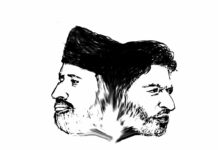TARIQUE A BHAT
What just happened? Who saw what? Was it really not what it looked like? What was it like? Some emotions are just silent this way. We need stories behind these words. The people who live and suffer through the consequences of protracted conflict ultimately deserve to be the architects of the changes required to improve their lives on the ground.
Looking back throughout our history, we’ve had our many younger generations, especially since last 60 years , fueled by passion, desire, early drive and belief that we can change this world of pain. By nature, we tend to be more on the dramatic side. Reason: One of the main victims of an extended period of uncertainty is the people’s capacity of positive conflict transformations, as being continuously surrounded by and submerged in conflict. We now consider problems and untoward environment as the “normal” and the only way of conflict resolution. Furthermore, individual and collective reticence, and stereotypes develop, and are being transmitted from adults to young generations.
In the last two decades, we have come of age. Many of our creative leaders. who kept the negative drama out of their process and used critical thinking as powerful tools for dealing with and transforming conflict. There are already well-written books like Curfewed Night, The Collaborator, Our Moon Has Blood Clots, to just mention a few. Our young authors are showing great courage and resilience by their ability through creative expression, sharing and encounter. There is so much going on in our lives, so much struggle in our minds, so much pain in our hearts, but words fail. We feel flooded with emotions and we feel empty at the same time.
Most probably, we need exploration of film as an art form and a medium of communication for strengthening the capabilities of the upcoming generations. Though underutilized reservoirs in Kashmir, dimensions of feeling, emotion, imagery and imagination are clearly important. Visual and other arts like, films, drama, music can stimulate a whole range of emotions and perceptions, some
forms of it uplifting and likely to work in favour of peace and conflict resolution.
Independent cinema, documentaries and fictional feature-length films from Kashmir perspective are bound to become a barometer of the times against the shroud of silence. We need to attempt to shed light on the realities of our society, pain we are going through, things that directly affect, move and worry our average citizen or societal stagnation. Films from Kashmir can be seen as harbingers of the current upheaval. Films can dramatize issues and their implications for society, and contribute to political debate.
Kashmir is the exceptional area without its own functioning film industry. Our films of the last more than two decades are funded by government and they have dealt with insurgency, development, life in a multicultural society, love, family, and the collective problems that are not much different from other parts of the world.
And perhaps that is the reason (except one or two), most of these films have not received much attention even in Kashmir, because they don’t show what we see as specifically Kashmiris. We have such compelling stories, strong characters that our filmmakers hardly need to make any outright political
statements, but can let the audience draw its own conclusions about the miseries by listening to and watching the experiences of the Kashmiris who live in the middle of all this. Still others can try to mobilize support for a position. We need to believe in power of visuals, in passion in true sense, in emotions painted with images.















